|
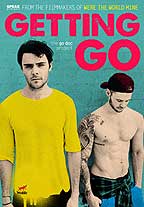
Getting Go,
The Go Doc Project
Wolfe Video,
2013
Director/Screenplay:
Cory Krueckeberg
Starring;
Tanner Cohen,
Matthew Camp,
Ramón Olmos Torres,
Judy McLane,
Tedd Merrit
Unrated,
91 minutes |
The World According To Doc
by
Michael D. Klemm
Posted online August, 2014

Fade in on an adorable young man who looks like the boy next door. He is drunk, and busy having a wank to a jerk-off website. Afterwards, he records his video blog. “I guess by now it’s clear I have a major problem,” he deadpans for the web camera. He is obsessed with a muscular and handsome go-go dancer, whom he has been stalking on the site, whose screen name is “Go.” He tells the chat room that “This time it feels… profound.” Not content to merely expose himself to the world with a “drunk posting” that he knows he’ll forget by the morning, he also impulsively sends Go an e-mail. Assuming that Go would never reply to his message, he pretends that he is filming a documentary about dancers and that he is looking for a subject who can be his “muse.” |
 The first minutes of Getting Go, The Go Doc Project certainly got my attention. The stage has just been set by a frantic (and funny) X-rated montage of jump cuts, split screens and self-deprecating voice-overs. Getting Go is an edgy, yet also at times poignant, look at an introverted young gay man who gets more than he bargained for when he meets his internet fantasy in the flesh. Tanner Cohen (Were The World Mine) plays “Doc,” a naïve gay kid who attends college in New York City. Doc has spent the last four years satisfied to live his sex life in cyberspace… until the object of his obsession answers the drunken e-mail he barely remembers writing the night before. Doc decides to pretend that he really is a filmmaker and see what happens. The first minutes of Getting Go, The Go Doc Project certainly got my attention. The stage has just been set by a frantic (and funny) X-rated montage of jump cuts, split screens and self-deprecating voice-overs. Getting Go is an edgy, yet also at times poignant, look at an introverted young gay man who gets more than he bargained for when he meets his internet fantasy in the flesh. Tanner Cohen (Were The World Mine) plays “Doc,” a naïve gay kid who attends college in New York City. Doc has spent the last four years satisfied to live his sex life in cyberspace… until the object of his obsession answers the drunken e-mail he barely remembers writing the night before. Doc decides to pretend that he really is a filmmaker and see what happens.
|
|
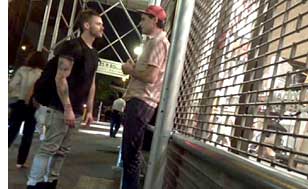 Much of this is funny. When Doc goes to the club where Go is dancing, he is such a nervous nerd that their meeting almost doesn't happen. Go (Matthew Camp) is surprisingly open to Doc’s proposal and agrees to be filmed. “I’ve always wanted my own Andy Warhol,” he explains. (“The soup can guy?” Doc asks, confused.) Doc borrows a camcorder from a friend and films Go at his home, at the gym, grocery shopping, grooming and, of course, dancing in his underwear in gay bars. Go opens up for the camera. He is an erotic dancer and a tattoo artist, but he’s also a painter. His favorite body part is his brain, and he often wears a hat when he dances so that he doesn’t have to make eye contact with his audience. We get to be voyeurs but that doesn’t mean that Go always has to look back at us. Despite Doc’s habit of asking interview questions about Go’s physique and his sex life, Go comes across as a man with a brain and not just a piece of meat. Much of this is funny. When Doc goes to the club where Go is dancing, he is such a nervous nerd that their meeting almost doesn't happen. Go (Matthew Camp) is surprisingly open to Doc’s proposal and agrees to be filmed. “I’ve always wanted my own Andy Warhol,” he explains. (“The soup can guy?” Doc asks, confused.) Doc borrows a camcorder from a friend and films Go at his home, at the gym, grocery shopping, grooming and, of course, dancing in his underwear in gay bars. Go opens up for the camera. He is an erotic dancer and a tattoo artist, but he’s also a painter. His favorite body part is his brain, and he often wears a hat when he dances so that he doesn’t have to make eye contact with his audience. We get to be voyeurs but that doesn’t mean that Go always has to look back at us. Despite Doc’s habit of asking interview questions about Go’s physique and his sex life, Go comes across as a man with a brain and not just a piece of meat.
|
 |
Until now, the socially awkward Doc has been hiding in the shadows behind a computer screen. He knows nothing about the gay night scene and Go begins pulling him out of his shell. Doc, despite a predilection for cybersex, is oddly timid and old fashioned. “I’m content with my online sex life,” he tells Go when things start suddenly getting serious, “I always assumed I’d wait for marriage.” It’s a foregone conclusion that our boys will eventually fuck. It’s very sexy when Go, who has been shirtless for most of the film, tells Doc to take off his. “You’re fuckin’ adorable,” he tells Doc, who replies, “No, I’m just scared.” Go tells Doc that even Warhol slept with his subjects and before long they are in bed - and the camera is still rolling. |
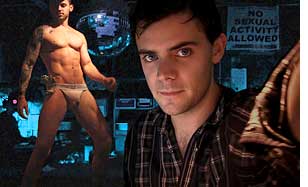 Getting Go is the debut film from writer/director/editor Cory Krueckeberg. He co-wrote the screenplay for his partner, Tom Gustafson’s, delightful 2008 movie, Were The World Mine (which also starred Cohen). With no funding options for his film projects happening anytime soon, he came up with a novel way to make a movie now without resources and money. Matthew Camp is an actual go-go dancer whom Krueckeberg had admired online. The director’s first thought was to make a documentary about Camp and then he sailed into autobiographical waters by making the movie about another obsessed man who just wants to film his idyll. Photographed on video, iPhones and webcams, Krueckeberg (with Gustafson) shot hours of footage for his no-budget feature. He also gave his actors the camera and let them film their big sex scene by themselves. Getting Go is the debut film from writer/director/editor Cory Krueckeberg. He co-wrote the screenplay for his partner, Tom Gustafson’s, delightful 2008 movie, Were The World Mine (which also starred Cohen). With no funding options for his film projects happening anytime soon, he came up with a novel way to make a movie now without resources and money. Matthew Camp is an actual go-go dancer whom Krueckeberg had admired online. The director’s first thought was to make a documentary about Camp and then he sailed into autobiographical waters by making the movie about another obsessed man who just wants to film his idyll. Photographed on video, iPhones and webcams, Krueckeberg (with Gustafson) shot hours of footage for his no-budget feature. He also gave his actors the camera and let them film their big sex scene by themselves.
|
 Conceptually, Getting Go is brilliant. It both celebrates and critiques online culture while also giving the voyeurs in the audience what they want. The internet has been a game changer by, paradoxically, making it easier to be more open and to be more impersonal all at the same time. Like all too many people, Doc finds it easier to connect with an internet stranger than to be with a real person. In the world according to Doc, going online makes it very easy to feed your obsessions. (During the film’s first minutes, Doc opens a picture of Go in Photoshop, erases Go’s underwear, and adds another man’s penis.) Go initially seems to just want his fifteen minutes of fame - and get paid for his efforts - but then unexpectedly feels attracted to Doc... who is scared of disease, pain, nudity, commitment, and would rather jerk off to an online abstract. Conceptually, Getting Go is brilliant. It both celebrates and critiques online culture while also giving the voyeurs in the audience what they want. The internet has been a game changer by, paradoxically, making it easier to be more open and to be more impersonal all at the same time. Like all too many people, Doc finds it easier to connect with an internet stranger than to be with a real person. In the world according to Doc, going online makes it very easy to feed your obsessions. (During the film’s first minutes, Doc opens a picture of Go in Photoshop, erases Go’s underwear, and adds another man’s penis.) Go initially seems to just want his fifteen minutes of fame - and get paid for his efforts - but then unexpectedly feels attracted to Doc... who is scared of disease, pain, nudity, commitment, and would rather jerk off to an online abstract.
|
 Doc’s interactions with Go are charming but also a little disturbing. When his obsession turns into longing, he becomes possessive and tells his video blog followers that he doesn’t want Go to be seen as an object by anyone but him. Their relationship will go through several twists and turns. Doc began their relationship by being dishonest, and uses Go as a pawn in his search to find himself. Later, when he feels betrayed, it’s impossible to think of him as anything other than a hypocrite. Doc’s interactions with Go are charming but also a little disturbing. When his obsession turns into longing, he becomes possessive and tells his video blog followers that he doesn’t want Go to be seen as an object by anyone but him. Their relationship will go through several twists and turns. Doc began their relationship by being dishonest, and uses Go as a pawn in his search to find himself. Later, when he feels betrayed, it’s impossible to think of him as anything other than a hypocrite.
|
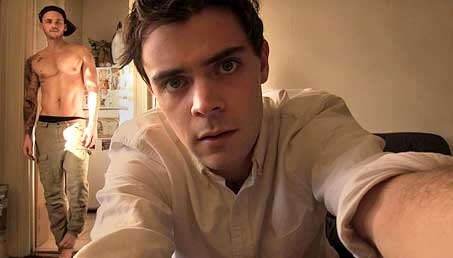 |
Getting Go is much more than just a voyeur’s delight. Amidst all the jumpy camerawork, split screens and abundant beefcake are intelligent dialogues about queer identity. Doc’s film thesis argues that “assimilation must be the goal of the queer community if true equality is ever to be won.” Go disagrees and counters that assimilation has “castrated queer culture” by “denying humanity’s radical need for diversity.” Go refuses to let his “uniqueness” disappear into a “void of political correctness” while Doc thinks it takes more courage to be average and boring. “So,” Go asks, “stalking a go-go boy is normal, but being one isn’t?” |
 Getting Go works on many levels and I liked the homage paid to Andy Warhol’s underground cinema. After Go tells the clueless Doc about Warhol, Doc watches the famed pop artist’s early silents (Eat, Sleep and Kiss) on YouTube and the result is what a Warhol film might look like re-imagined today through this college senior’s eyes. A close-up of Go eating lasts several minutes. A similar long take, with split screens, shows Go sleeping and, later, Go and Doc kiss in a series of sexy extended close-ups. The scene where Doc films Go grooming in the bathroom seems to channel the second reel of Warhol’s My Hustler. Krueckeberg is plugging into a pretty good vibe here and, considering the film’s deliberate non-budget, the allusions to Warhol are apropos. Getting Go works on many levels and I liked the homage paid to Andy Warhol’s underground cinema. After Go tells the clueless Doc about Warhol, Doc watches the famed pop artist’s early silents (Eat, Sleep and Kiss) on YouTube and the result is what a Warhol film might look like re-imagined today through this college senior’s eyes. A close-up of Go eating lasts several minutes. A similar long take, with split screens, shows Go sleeping and, later, Go and Doc kiss in a series of sexy extended close-ups. The scene where Doc films Go grooming in the bathroom seems to channel the second reel of Warhol’s My Hustler. Krueckeberg is plugging into a pretty good vibe here and, considering the film’s deliberate non-budget, the allusions to Warhol are apropos.
|
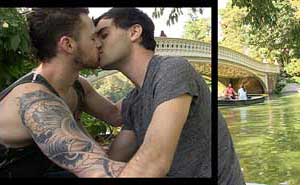 The film was scripted (with touches of improvisation) and the two leads make it all look spontaneous. Cohen and Camp are terrific together and I can’t imagine this film with anyone else. Cohen’s innocence, coupled with a golden singing voice, won my heart in Were The World Mine, making his presence in Getting Go most welcome. (He has “grown up” rather nicely too.) Camp is sometimes just playing himself but that doesn't detract from his performance. He is a natural on camera, not to mention being easy in the eyes. Their intimate interludes are – I won’t beat around the bush – hot. The film was scripted (with touches of improvisation) and the two leads make it all look spontaneous. Cohen and Camp are terrific together and I can’t imagine this film with anyone else. Cohen’s innocence, coupled with a golden singing voice, won my heart in Were The World Mine, making his presence in Getting Go most welcome. (He has “grown up” rather nicely too.) Camp is sometimes just playing himself but that doesn't detract from his performance. He is a natural on camera, not to mention being easy in the eyes. Their intimate interludes are – I won’t beat around the bush – hot.
|
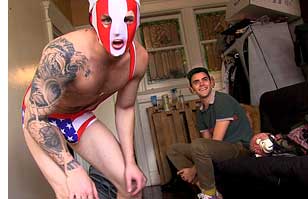 This is a love story for the new millennium. Much of Getting Go is filmed and edited in a hyper-kinetic style. Considering the film's subject matter, the flashy faux documentary found footage video project approach was definitely the way to go. It is effective but it also gets repetitive at times. To be honest, I can only take speeded up footage in moderation and the slow “Warhol scenes” provided a nice contrast. (A brief sequence on Fire Island would have been much better if there was less waving for the camera and if it was projected at the normal speed.) Many of the music choices are unusual and add interest. The narrative is more fragmented in the last half hour and, for this reviewer, meandered in the home stretch. The ending didn’t thrill me but I was captivated by most of the film’s running length. This is a love story for the new millennium. Much of Getting Go is filmed and edited in a hyper-kinetic style. Considering the film's subject matter, the flashy faux documentary found footage video project approach was definitely the way to go. It is effective but it also gets repetitive at times. To be honest, I can only take speeded up footage in moderation and the slow “Warhol scenes” provided a nice contrast. (A brief sequence on Fire Island would have been much better if there was less waving for the camera and if it was projected at the normal speed.) Many of the music choices are unusual and add interest. The narrative is more fragmented in the last half hour and, for this reviewer, meandered in the home stretch. The ending didn’t thrill me but I was captivated by most of the film’s running length.
|
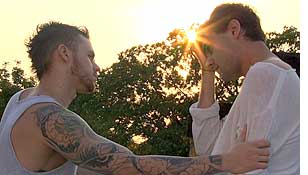 The film’s technique makes a certain amount of sloppiness inevitable but, despite flaws, Getting Go proves that you don’t need a mega-budget to create memorable cinema. This is certainly not a formulaic film made on an assembly line. Take a walk on the wild side; you’ll be glad you did. The film’s technique makes a certain amount of sloppiness inevitable but, despite flaws, Getting Go proves that you don’t need a mega-budget to create memorable cinema. This is certainly not a formulaic film made on an assembly line. Take a walk on the wild side; you’ll be glad you did.
More on Cory Krueckeberg :
Were The World Mine
Tanner Cohen also appears in:
Were The World Mine
More on Andy Warhol:
My Hustler |



